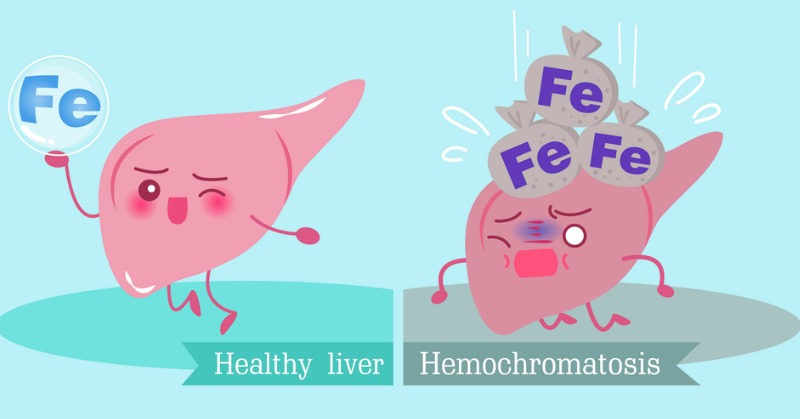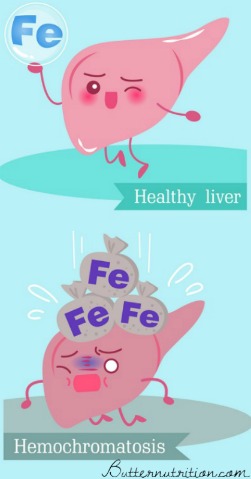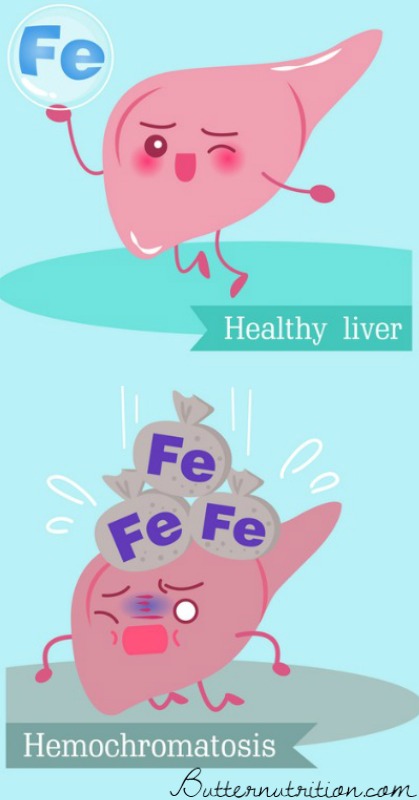
Some speculate that the genetic mutation associated with hemochromatosis may have emerged as a protective mechanism to prevent iron deficiency in humans as they transitioned to a carbohydrate heavy diet based around farming and agriculture from the previous hunter-gatherer centered diet. [11]
Excess iron acts as a rusting agent in your body and can accumulate in tissues, particularly in the liver, pancreas, heart, joints and the brain. This speeds up the aging process and puts you at a much higher risk for vascular disease, cancer, and a shortened life expectancy. Iron overload is also linked to liver disease, cardiovascular disease, gout, infertility, hypothyroidism, and a very long list of others, making it essential for you to know your iron status. [10]
The Signs and Symptoms of Iron Overload:
While the symptoms are often silent in the early stages of hereditary hemochromatosis or iron overload, as it progresses it can lead to:
- Heart arrhythmia
- Diabetes
- Hypothyroidism
- Hormonal problems
- Loss of libido
- Infertility
- Impotence
- Heart disease
- Liver disease and cirrhosis
- Yellowing of the skin
- Joint pain
- Weakness
- Nausea
- Abdominal pain
- Arthritis
- Weight loss
- Hair loss
- Depression
- Fatigue
*Typically iron saturation and serum iron are the first to creep up outside the normal range in iron overload. High bilirubin, and elevated liver enzymes on lab tests can also hint at iron overload. [5]
How common is hereditary hemochromatosis or iron overload?
There are two major HFE (high iron) genes that cause overload: C282Y and H63D.
The common diagnosis for hemochromatosis by the medical community requires having two copies (one from each parent, called homozygous) of either C282Y or H63D for disease to develop. Based on genetic estimates, this is present in about 1 in 200 Caucasians, making hemochromatosis one of the most prevalent genetic diseases in North America. [10,13]
However, even those without the standard hereditary hemochromatosis diagnosis can have a tendency toward iron overload. Those who are carriers or heterozygous with only a single copy of either HFE gene can display symptoms of iron overload. A person can also have one copy of both C282Y and H63D (called compound heterozygous), increasing the symptomatic probability. Because symptoms can manifest in carriers, it is commonly missed or overlooked by conventional medicine.
Furthermore, there are at least 20 other mutations have been identified but are not currently understood at this point by the medical research community.
Considering that approximately 1 in every 3 people are carriers for one of the major hemochromatosis genes and there is currently no national screening program in place, there could be a large undiagnosed population. An iron panel was a standard part of yearly blood work until about 1996-1997, but now it's typically only done if requested or your doctor has a reason to do so.
That's why testing your iron levels and knowing your genetics is key to staying ahead of your health.
How do you find out if you are at risk for iron overload?
According to the Iron Disorders institute, you are most at risk for iron overload if:
- Your ancestors are from Northern Europe.
- You have a family history of heart trouble, especially early death by heart attack or a history of diabetes, liver disease, osteoarthritis, hormone imbalances, especially hypothyroidism, or infertility.
- You are male, or a postmenopausal female who is no longer menstruating (as menstruating women lose some iron naturally with their monthly cycle).
- You are homozygous for the C282Y mutation of the HFE gene, homozygous for the H63D HFE gene, compound heterozygote (C282Y/H63D) and some carriers.
There are two essential steps for finding out your risk of hereditary hemochromatosis or iron overload. Some choose to do a blood test first, while some choose to do genetic testing as a first step. It's really up to you and your health support team.
With Genetic Testing: You used to be able to order an ancestry report through 23andMe that would give you all your raw genetic data, which you could then hack by following the simple protocol below to understand if you are at risk of iron overload. However, 23andme is constantly updating what is included in the raw data (read: less data is included with every "chip" update as they call it). I called and verified that these are currently still included, but I can't make any promises that it will stay that way, so it is best to check with them before you check out.
Here's an example of the HFE gene C282Y (risk allele A) on the 23andMe raw data browser:
Because the genes present in this example are A / G, and A is the risk allele, this person would be heterozygous (one copy or a carrier) for C282Y.
Here's an example of the HFE gene H63D (risk allele G):
Because the genes present in this example are C / G, and G is the risk allele, this person would be heterozygous (one copy or a carrier) for H36D.
This person is heterozygous for both C282Y and H63D HFE genes, so they classify as compound-heterozygous because they have one copy of both of the common iron overload genes.
Order a 23andMe report right here for $99.
Blood work: Requesting blood work another essential step to determine your risk of iron overload, especially if you have the genes for it. Typically, you'll want an iron panel at the very least, which usually includes serum iron, total iron binding capacity (TIBC), transferrin saturation, and overall ferritin (or iron stores in the body), but your doctor might have other specifics, such as a complete blood count (CBC), comprehensive metabolic panel (CMP), and Gamma-Glutamyltransferase (GGT) in addition to give a bigger picture of your overall health, since some other health conditions can mimic the symptoms of iron overload.
An iron panel and ferritin is included in my nutrient blood labs package that can be added on to any 1-1 consultation (available to US clients only, except NY, NJ and RI).
I found the following forms helpful for interpreting your own iron panel results here and here, but it's always best to work your healthcare professional on this.
How to reduce high iron levels
If you find yourself with iron overload genes and/or high iron levels, you'll want to work carefully with your healthcare professional to monitor your iron over time and establish a plan to reduce and maintain optimal iron levels. Iron overload and hemochromatosis isn't something that you can ever be "cured" of, but you have to manage it for a lifetime by always keeping your iron levels in check. The most common ways to reduce iron levels over time are:
- Blood donation at a frequency that correlates to your iron levels
- Therapeutic phlebotomy (Rx prescribed bloodletting to donate blood more frequently)
- Eat less iron from food like red meat and liver, although restricting your diet too much can cause other nutritional deficiencies, making blood donation the most common intervention
- Avoid foods fortified with iron (most processed foods) and iron supplements, including iron-containing multivitamins
- Reduce or limit alcohol consumption, as alcohol increases iron absorption
The more you know about your body in the ways of data by way of blood lab testing, hair analysis, and genetic testing, the more you can adjust your diet, supplements and lifestyle to support the best possible health for you. Having struggled with iron overload, undermethylation, hypermobility, and nutritional deficiencies myself, I don't know where'd I'd be without the knowledge and data to help me find my path to true health.
Do you have hereditary hemochromatosis or high iron levels? Please share in the comments!
PIN IT:
References:
- http://www.irondisorders.org/Websites/idi/files/Content/854256/HHC%20ALL2011.pdf
- http://www.irondisorders.org/Websites/idi/files/Content/854256/HHC%20FACT2010.pdf
- http://www.irondisorders.org/Websites/idi/files/Content/854256/Physician%20Chart%20phlebotomy%20detail2011.pdf
- https://www.ncbi.nlm.nih.gov/pubmed/11479183
- https://www.ncbi.nlm.nih.gov/pubmed/15266614
- http://www.hopkinsmedicine.org/hematology/fellows/summer%20course/slides/Spivak_IronOverload%2007.27.12.pdf
- https://www.ncbi.nlm.nih.gov/pmc/articles/PMC3821171/
- http://www.townsendletter.com/May2009/chelation0509.htm
- https://articles.mercola.com/sites/articles/archive/2017/05/31/managing-iron-levels.aspx#_edn10
- https://chriskresser.com/iron-behaving-badly-the-role-of-iron-overload-in-metabolic-disease/
- https://articles.mercola.com/sites/articles/archive/2013/06/05/elevated-iron-levels.aspx
- https://hemochromatosishelp.com/turmeric-benefit-for-hemochromatosis/
- https://www.sciencedirect.com/topics/medicine-and-dentistry/hemochromatosis










Lynne kitchen
Thank you for sharing this! I discovered that insurance companies look at Ferritin and GGT levels when rating or denying life insurance !Mine was low but my husband who is a non drinker was 224 ! Since he's not a drinker I researched and found that iron levels are most likely the culprit . So we did blood donation and I'm also doing a lot of nutritional things to support detox of the liver . Everyone needs to know this info that you've shared! Again thank you! Health is wealth
Kieran
On the iron disorders site it says normal transferrin saturation is 25-35% and my iron panel just came back with and TS of 47% and this is after giving blood twice already, my ferritin is 90 though
Angela
My husband is finally getting getting diagnosed by a specialist. He is 55 and it has been 10 years of tests and monitoring of symptoms before ordering phlebotomies.
Emily
This is a great post and good to make people aware of something they may not have considered before.
Katy Walsh
Hi. I am 52, still get my periods monthly and I have experienced since 2013, extreme exhaustion, vertigo, chronic sore throat, extreme dry mouth among many other symptoms. I took 23 and me and I tested positive for 1 gene for Hemochromatosis-the H63D. My iron test came back high, but my ferritin is low. I also found out my sugar was high (does not make sense since I eat well, work out, etc), however, I cannot lose weight.
I do not know what type of doctor to go to in order to feel well. I am petrified about my high iron, yet, with a ferritin if 13, I am afraid to give blood, Any advice on where to start? I thank you.
Mak
You should see a good Endocrinologist. They may be helpful.
Rob
I am 43 and, even though I am a healthy weight, exercise, and eat a relatively healthy diet my liver numbers have been quite high the last few years. They always attributed it to fatty liver and just told me to eat healthier and drink less. Around 40 I started having other symptoms. Joint pain, tendonitis, fatigue, etc. and I finally convinced my doctor to do more. My ferritin was over 700 and my liver numbers were high too. I got a 23 and me test done and I am heterozygous for H63D. I told my doctor this and she finally is willing to do more. I get my "official" genetic test this week and hope to start treatment soon. I am glad I caught it early.
Felice
Thanks for this info. I have not had any tests as yet, but suspect high Fe levels because of symptoms. I have been eating raw spinach salads for many many years almost daily which I realize now could be part of the problem. QUESTION: has anyone heard of or experienced plupurae (purple-ish bluish spots on their skin? I was wondering if high Fe has been suspect in causing them? thank you.
Emma
please look into oxalates if you are eating that much spinach
Judy Miller
Thank you for all your great knowledge. I've learned so much from your emails. You are the best. Judy miller
Catherine
Thank you Judy <3
Brittany
Hi Catherine does low methylation contribute to high iron (in hair) low in blood?
Rachel
Could very heavy periods be a sign of iron overload?
Pamela
Heavy periods are a sign of low progesterone levels.
raina
this was hugely helpful for me! thank you! I feel empowered by what you shared & ready get the data I need to take control of my wellbeing. Deeply grateful xx
steve schipper
My wife is one of the rare ones with CDA Type II and has recently been found to have iron overload. Of course with a non iron deficiency anemia she cannot do the phlebotomy methods. The CDAs are not common but with not testing iron panels there is a good chance there could be more non iron deficiency anemias. In my family practice, where I am a MLT, the iron panels we run are almost always normal, even the ones run on women. Our providers tend to order anemia panels on those with variant HgB, but probably 95% of transferrins, retics and Foalte, Vb12 results are normal. I find the understanding of MCV results is becoming better but still not pursued by most providers.
Luan Meredith
I have known for years about my hemochromatosis....
It's great to see all the information you provide here.
I have both genes...and have done therapeutic phlebotomies since receiving the knowledge of my condition. Currently, I am 75 years old...and found this out at age 37. So...do the math!
I"m healthy (as far as I know) I walk between 1 and 3 miles every day. I live an active social life with my husband and friends. I've semi retired from being a "real estate broker" and running a brokerage. The doctor that replaced my retired liver guy doesn't have the same sense of urgency that my previous doctor has. He is unconcerned as long as the total iron is 50 or less. And, he cares not to know about the transferritan percent...
I'm considering changing doctors. I know my body so much better than this guy. I can feel the fatigues and the stiff joints....and I think I'm ready to have another phlebotomy. My phlebotomies are typically a "half pint" because I'm a small person and a whole pint does not work well.
So...there's my story for now. I hope it is of interest and maybe shows someone who is new with this disease there is hope...and life can be totally normal . Just take care of yourself!
My current challenge is the new